Trailering "101" from
the AOSA.
| Introduction
- The following information is provided to assist Edmonton area sailors
who trailer a boat to/from Wabamun Lake or beyond.
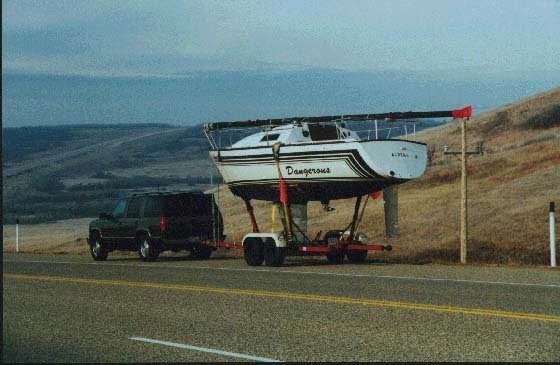 My own experience with trailering has for the most part been enjoyable,
allowing our family to experience other sailing locations. These include
Sylvan lake, Cold Lake, Lesser Slave Lake, Shushwap, Flathead Lake
in Montana and a two week cruise around the Gulf Islands in BC. My own experience with trailering has for the most part been enjoyable,
allowing our family to experience other sailing locations. These include
Sylvan lake, Cold Lake, Lesser Slave Lake, Shushwap, Flathead Lake
in Montana and a two week cruise around the Gulf Islands in BC.
Our desire to own a certain type of boat and to keep the cost of boat
ownership reasonable has meant that we bought our boats outside Alberta.
Our first boat, "Chirpy," a Sandpiper from Parksville, Vancouver
Island. Our second boat, "Juander," a San Juan 23 MKI. Our third
boat, "Our Juan," a San Juan 23 MKII from Anacortes, Washington. Our
current boat, Runaway, a San Juan 7.7M from Alpena, Michigan.
Planning your trip properly will ensure that you arrive at your
destination safely, on schedule and relaxed sufficiently to enjoy your
time on the water.
Duncan Cook
S.V. Runaway
San Juan 7.7M |
Trailer Information
|
Most people purchase their boat complete with a trailer.
Trailers are built to conform to applicable standards at the date of
manufacture.
-
In Canada this standard is CANADIAN
MOTOR VEHICLE SAFETY STANDARDS, (CMVSS).
-
In the US the standard is the FEDERAL
MOTOR VEHICLE SAFETY STANDARDS, (FMVSS).
GROSS VEHICLE WEIGHT RATING (GVWR)
- The GVWR is a safety standard designed to
prevent overloading. Simply put it is the maximum weight your vehicle is
designed to carry. This includes the net weight of the vehicle, plus the
weight of passengers, fuel, cargo and any accessories added to the
vehicle after purchase.
HOW
IS THE GVWR DETERMINED? - Each
manufacturer determines the maximum acceptable weight limit for a
vehicle by considering the combined weight of the strongest weight
bearing components (the axles) and the weaker components (body, frame,
suspension, and tires). When these are factored in, the manufacturer
sets the vehicle’s GVWR in accordance with standards set by Transport
Canada.
|
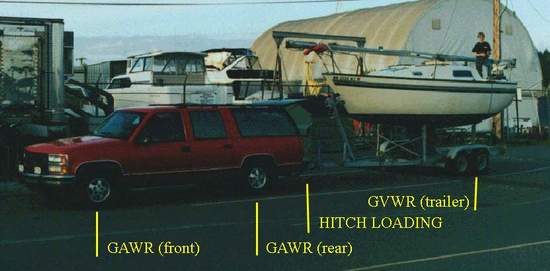 LOADING
ABOVE A VEHICLE'S GVWR RATING? - Vehicles
that operate above the GVWR are a potential safety hazard because the
frame, suspension, brakes and tires are not designed for weights above
the rating the manufacturer
has set. Overloading a vehicle can also result in increased maintenance
costs. The Motor Vehicle Act of British Columbia prohibits an operator
from loading the vehicle in excess of its GVWR. LOADING
ABOVE A VEHICLE'S GVWR RATING? - Vehicles
that operate above the GVWR are a potential safety hazard because the
frame, suspension, brakes and tires are not designed for weights above
the rating the manufacturer
has set. Overloading a vehicle can also result in increased maintenance
costs. The Motor Vehicle Act of British Columbia prohibits an operator
from loading the vehicle in excess of its GVWR. |
Hitches and Safety Chains
|
| Trailer Classification & Coupler Designation |
DESCRIPTION |
BALL Diameter. |
Min Breaking Force of Safety Chain or Cable |
| CLASS 1 |
All
types of trailers with a trailer Gross Vehicle Weight Rating (GVWR)
(trailer weight including its load) not to exceed 910 kg (2000 lb.). |
47.6mm
(1
7/8)" |
8.9
Kn.
(2000
lb.) |
| CLASS 2 |
All
types of trailers with a trailer GVWR of over 910 kg (2000 lb.) and not
to exceed 1590 kg (3500 lb.). |
50.8mm
(2)" |
15.6
Kn.
(3500lb.) |
| CLASS 3 |
All
types of trailers with a trailer GVWR of over1590 kg (3500 lb.) and not
to exceed 2270 kg (5000 lb.). |
50.8mm
(2)" |
22.2
Kn.
(5000
lb.) |
| CLASS 4 |
All
types of trailers with a trailer GVWR of over 2270 kg (5000 lb.) and not
to exceed 4540 kg (10000 lb.). |
See
Note #1 |
The
strength rating must be equal to or exceed the minimum breaking force of
the GVWR of the trailer |
| NOTE #1 - Ball and bolt shall be of such size and strength as to conform to the
minimum breaking strength requirement of the mating coupling for the
specific load of class 4 trailer. |
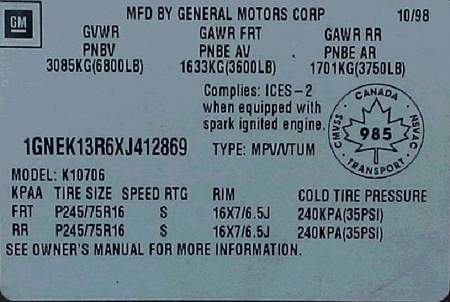
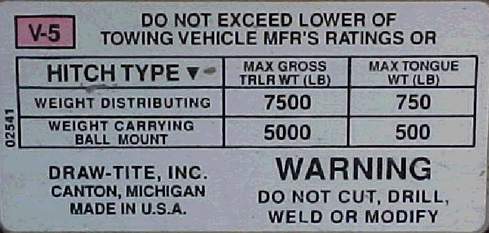
LIGHTING REQUIREMENTS

| TRAILER
LIGHTS |
| AREA |
LIGHT |
PURPOSE |
QTY |
COLOUR |
LOCATION |
HEIGHT (from the ground) |
| 1 |
Tail lamps |
Indicate vehicle's presence and width |
Min 2 |
RED |
On the rear- symmetrical as far apart as practical |
380-1830
(15-72)" |
| Stop lamps |
Indicate braking |
Min 2 |
RED |
On the rear- symmetrical as far apart as practical |
380-1830
(15-72)" |
| Rear turn signal lamps |
Indicate direction of turn |
Min 2 |
RED or YELLOW |
On the rear- symmetrical as far apart as practical |
380-2110
(15-83)" |
| Rear reflex reflectors |
Indicates vehicle presence and width |
Min 2 |
RED |
On the rear- symmetrical as far apart as practical facing rearwards |
380-1530
(15-60)" |
| 2 |
License plate lamp |
Illuminate license plate |
Min 1 |
WHITE |
On the rear above or at the side of license plate |
No
Reqmt |
| 3 |
Rear side marker lamps |
Front and rear side marker lamps/ side reflex reflectors indicate
vehicle's presence and width |
Min 2 |
RED |
Each side at rear- as far back as practicable |
380-1530
(15-60)" |
| Rear side reflex reflectors |
Min 2 |
RED |
Each side at rear- as far back as practicable facing sideways |
380-1530
(15-60)" |
| 4A |
Front side marker lamps |
Min 2 |
YELLOW |
Each side at front as far forward as practicable |
380
(15)" MIN |
| 4B |
Front side reflex reflectors |
Min 2 |
YELLOW |
Each side at front as far forward as practicable facing sideways |
380-1530
(15-60)" |
ADDITIONAL LIGHTS FOR TRAILERS EXCEEDING Length 9.1m ( 30') or LONGER
|
| 5a |
Intermediate side marker lamps |
Indicate presence of a long vehicle |
Min 2 |
YELLOW |
Each side near center facing sideways |
Min 380
(15)" |
| 5b |
Intermediate side reflex reflectors |
Min 2 |
380-1530
(15-60)" |
| ADDITIONAL LIGHTS FOR TRAILERS EXCEEDING Width 2.032m ( 80") or
WIDER |
| 6 |
Rear clearance lights |
Show vehicle width, may not be combined with taillights |
Min 2 |
RED |
At the widest point - symmetrical on the rear or on the rear facing
rearward |
As high as practical |
| 7 |
Rear identification lamps |
Indicate presence of a wide vehicle |
Exactly 3 |
| 8 |
Front clearance lamps |
Show vehicle's width |
Min 2 |
YELLOW |
At the widest point - symmetrical on the front or on the front facing
forward |
As high as practical |
BARGMAN 7 & 9 CIRCUIT TRAILER WIRING
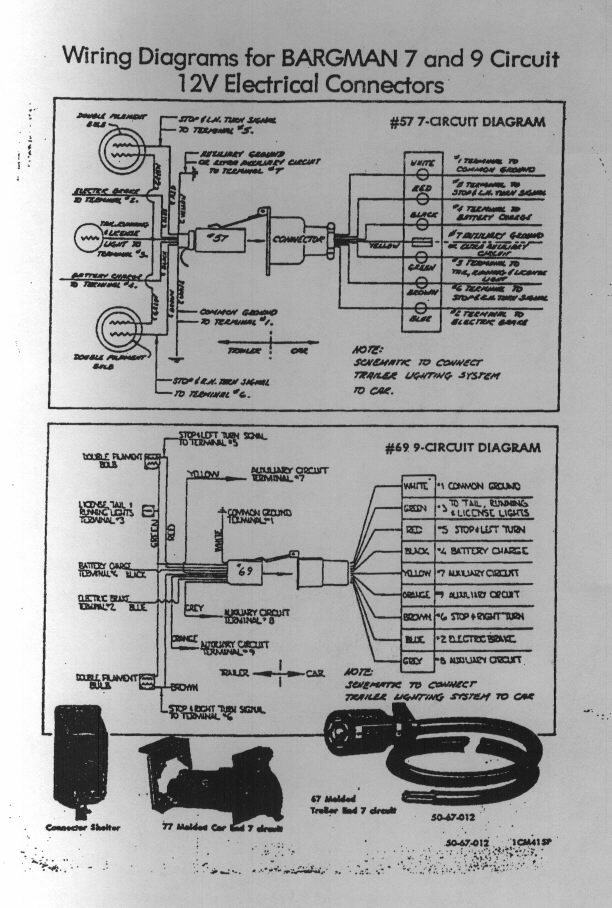
BRAKE REQUIREMENTS
ALBERTA HIGHWAY TRAFFIC ACT,
TRAILER BRAKE STANDARDS
16 (1) For the purposes of this subsection, brakes for a vehicle that
tow a trailer are adequate if;
(a) The combination of the towing unit and
trailer are capable of stopping within the distance and conditions set out in
section 44 of the act, and
(b) The brakes are capable of controlling the safe movement of the towing
unit
16 (2) Subject to subsection (3) no person shall operate a vehicle
that tows a trailer unless the trailer is equipped with adequate brakes.
16 (3) the following trailers do not require brakes;
(a) A trailer that has a gross laden weight
under 907.2 kg. / 2000 lbs.
(b) A trailer that has a gross laden weight of less than half the weight
of the tow vehicle.
ALBERTA PUBLIC VEHICLE
GENERAL EQPT & SAFETY ACT
18 (1) A trailer shall not be operated on a highway unless it is
equipped with brakes that are adequate;
(a) To control the movement of, and
(b) To stop and hold the trailer whether loaded or unloaded, under all
conditions
18 (2) The brakes referred to in subsection (1) must be designed and
installed so that those brakes may be applied by the operator of the towing
vehicle from the cab of the tow vehicle.
18 (3) Subsection (1) and (2) do not apply to the following;
(a) Subject to clause (b) and (c), to a
trailer having a maximum gross weight of not more than 2300 kg.
(b) To a pole trailer (not applicable!)
(c) To a farm trailer (also not applicable!)
18 (4) Notwithstanding subsection (3) (a) unless the tare weight of
the tow vehicle is at least twice the weight of the trailer, the trailer must
meet the requirements of subsections (1) and (2).
B.C. BRAKE REGULATIONS
All trailers and car towing dollies must have brakes on all wheels when the
G.V.W. (Trailer/dolly and load) exceeds 1400 kg (3086 lbs.). All trailers with
brakes must have a breakaway device hooked to the trailer system.
Surge brakes may be used up to a towed vehicle gross weight (G.V.W.) of 2800
kg. (6173 lbs.).
From 2800 kg and up the towed vehicle brakes must be able to be applied by
the driver of the tow vehicle.
SAFETY CHAINS
BC regulations require that all vehicles being towed via a ball hitch must
have safety chains or cables.
Regulations in the Alberta Highway Traffic Act requires;
10 (1) No trailer shall be towed unless there are two separate means
of attachment to the towing vehicle and the trailer is so attached that the
failure of one attachment does not permit the trailer to become detached from
the tow vehicle
10 (2) Each means of attachment must have sufficient strength to pull
the towed vehicle weight.
10 (3) The secondary means of attachment must be capable of
(a) Towing the trailer so that the trailer
substantially follows in the track of the towing vehicle, and
(b) Preventing the drawbar of the trailer or the primary means of attachment
from contacting the road surface.
TOW VEHICLE INFORMATION
ALBERTA HIGHWAY TRAFFIC ACT
19 Towing standards: no person shall operate a vehicle that tows
another motor vehicle unless the means of attachment.
(a) Is of sufficient strength to pull all
weight that is being towed, and
(b) Is designed to be capable of towing the motor vehicle so that the
vehicle follows in the track of the towing vehicle.
Both Alberta and BC require that the G.V.W.R. and the G.A.W.R. of the tow
vehicle specified by the vehicle manufacturer must not be exceeded. The
decal/label is normally attached on the drivers door post.
At this time there is no legislation in effect pertaining to the vehicle
manufacturers recommended maximum towing capacity. Individual components,
hitches, balls, safety chains, and G.A.W.R. must comply with regulations. Common
sense should be exercised to ensure that your tow vehicle has the capacity to
keep you and the rest of the motoring public safe.
PERMIT INFORMATION
The majority of boat owners do not have to obtain an over dimensional permit
to transport their boat on its trailer, but for those people who have a boat
wider than 2.6m (8’6") here is an overview of what is involved in getting
a permit.
MAXIMUM
"LEGAL" DIMENSIONS BEFORE A PERMIT IS REQUIRED ARE AS FOLLOWS;
| MAXIMUM WIDTH |
2.6 METERS / 8’ 6" |
| MAXIMUM HEIGHT |
4.3 METERS / 14’ 2" |
| MAXIMUM LENGTH (TRAILER) |
12.5 METERS / 41’ 0" |
| MAXIMUM LENGTH (COMBINED) |
20.0 METERS / 65’ 7" |
To obtain an over dimensional permit from the Alberta authorities, Alberta
infrastructure, Motor Transport Services in RED DEER
@ 1-800-662-7138, your tow vehicle must be registered as a commercial
vehicle, not a private vehicle.
My discussions with Alberta. Infrastructure have indicated that new
legislation will be coming to allow private citizens to obtain a permit without
a commercial license, but it is not in place at the time of this writing.
Alberta Infrastructure indicated that they have a greater concern with the
condition of the equipment towing the trailer and the capability of the people
driving these rigs.
My personal interpretation of this conversation is this. "If your
vehicle and trailer combination meets all the safety requirements of the highway
traffic act and falls within the conditions requiring you to have an over
dimensional permit, you will not be prosecuted for the lack of a permit. There
is no policy that allows a private citizen to obtain a permit."
BC. regulations follow the same format as Alberta for dimensions requiring a
permit. Despite the fact that all trucks registered in BC. are licensed as a
commercial vehicle, BC will issue an over dimensional permit to an out of
province passenger (private) vehicle.
An over dimensional permit can be obtained from the first
weigh scale you visit in BC. Or you can phone for a permit at 1-800-559-9688.
You will receive your permit via FAX. Payment may be made by Visa or
Master Card.
THE FOLLOWING INFORMATION IS REQUIRED WHEN APPLYING FOR A PERMIT;
Tow vehicle registration information.
Trailer registration information.
Overall length, width and height of tow vehicle and trailer.
Departure and destination points.
Route you wish to take.
A typical trailer up to 10’6" wide may travel 24 hours a day, 7 days a
week. The load must have flags attached at the widest point and have additional
side marker lights for night travel.
The lower mainland, from Abbottsford to Vancouver, has a curfew period for
loads exceeding 8’6."
This is in effect from 07:00 hrs to 09:00 hrs. and
from 15:30 hrs to 18:00 hrs.
The current cost for a single trip over-dimensional permit in Alberta or BC
is $15.00.
CLOSING - For our boat
delivery trip from Duluth to Edmonton in November 1999, I obtained my permits
from Minnesota, Manitoba, Saskatchewan and Alberta. Fees varied, with the most
expensive being Minnesota $30.00, Manitoba $6.00, Saskatchewan was free and
Alberta was $15.00.
My 1998 GMC Tahoe is licensed as a commercial vehicle to qualify for an
Alberta permit. At a licensed gross vehicle weight of 5300 KG it costs more than
a passenger plate but the peace of mind may well be worth the extra cost.
Duncan Cook,
Owner. "Runaway"
San Juan 7.7M,
2000-01-06
 My own experience with trailering has for the most part been enjoyable,
allowing our family to experience other sailing locations. These include
Sylvan lake, Cold Lake, Lesser Slave Lake, Shushwap, Flathead Lake
in Montana and a two week cruise around the Gulf Islands in BC.
My own experience with trailering has for the most part been enjoyable,
allowing our family to experience other sailing locations. These include
Sylvan lake, Cold Lake, Lesser Slave Lake, Shushwap, Flathead Lake
in Montana and a two week cruise around the Gulf Islands in BC. 


